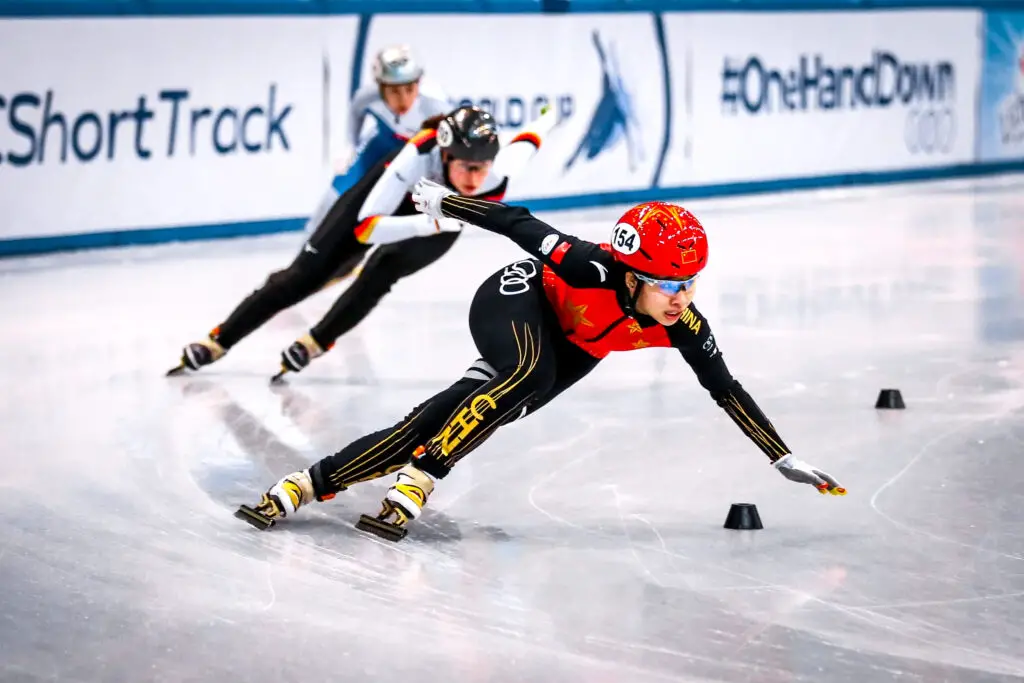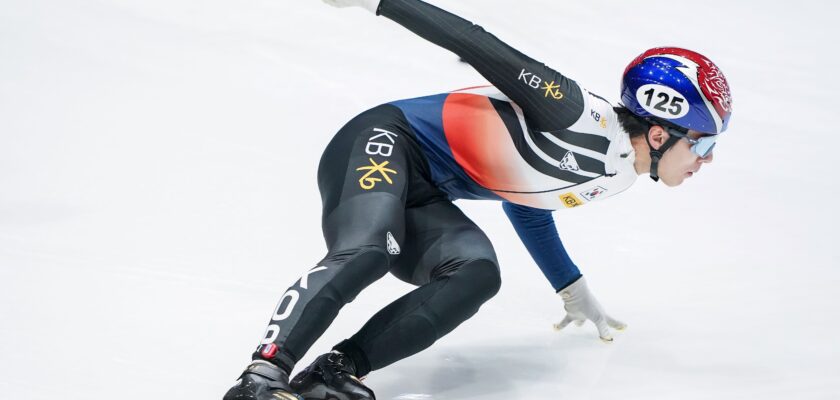Short track speed skating is a type of ice skating that takes place in arenas and differs from traditional speed skating due to the collective start and the competition format divided into multiple phases. Check out everything about short track speed skating now!
Open your Betano account and get up to 1,000 reais in bonuses.
Payments via PIX, live games and super odds!
Click here to open your account!

All about Short Track Speed Skating: history
Short track skating had its origins in Canada and the United States at the beginning of the 20th century, when long track skaters (400 meters) began to use ice hockey courts for their training. The first recorded official competition took place in 1909;
In the early decades of the century, it was common for Madison Square Garden in New York to fill up for events in this sport, which was beginning to become popular in Europe, Australia and Japan.
It wasn’t until 1967 that the sport was managed by the International Skating Union, although there have been international competitions for a long time;
Read on and find out all about short track speed skating!
The first competitions organized by the ISU took place in the 1970s, but the first World Championships were only held in 1981 in Meudon, France;
From 1984, the use of helmets became compulsory due to the frequent crashes during races.
In 1988, short-track speed skating was included in the program of the Calgary Winter Olympics as a demonstration sport. In the following edition, in Albertville, it was included in official events.
Initially dominated by breeding countries, short track speed skating has seen a significant increase in participation from Asian countries such as China and South Korea in recent years.
Countries such as the United Kingdom, Australia, Belgium, France and Japan played a crucial role in the sport’s development, taking part in open international competitions before official recognition by the International Skating Union (ISU);
In 1967, the ISU officially recognized short-track speed skating as a sport, but world-level international competitions didn’t begin until 1976.
Continue reading and learn all about short track speed skating!
All about Short Track Speed Skating: rules and regulations
Track
Diagram of the skating rink, highlighting the auxiliary curves and the adjusted start lines.
The rink must be set up on an ice rink with minimum dimensions of 60 x 30 meters for international competitions, and has a length of 111.12 meters;
Straights must be at least 7 meters wide and the distance between the center of the curve and the guardrail must be at least 4 meters.
To maintain ice conditions, in the shorter races, four additional curves are designed on each side, between one and two meters from the main curve, both outwards and inwards;
To balance the distance traveled in the bends, the starting line is adjusted, ensuring that the total route is always the same, regardless of the bend used. Each curve has seven marking blocks to prevent shortcuts.
The sides of the court are covered with mattresses to absorb the impact in the event of falls, and in ISU competitions and the Winter Olympics, it is compulsory to have equipment to produce images of the exact moment of arrival (photo finish).
Continue reading and learn all about short track speed skating!
Arbitration
Referees analyze the replay of a race at the 2012 Winter Youth Olympic Games.
The refereeing of short-track speedskating competitions is led by the General Referee, who is responsible for the final decision on protests, event management and compliance with the rules;
He is assisted by:
- Assistant Referee;
- Video Assistant;
- Match Judge;
- Competition Inspector (who organizes the heats);
- Beacon Inspector (calls the skaters to the next heat);
- Photo Finish judge (checks the times and reports the official result);
- Arrival inspectors;
- Timekeepers (in competitions without photo finish);
- Lap Marker (indicates the remaining laps);
- Lap Recorder (records the leader’s times on each lap).
Only the General Referee, the Assistant Referee and the Track Marshals may remain on the court during the races.
Continue reading and learn all about short track speed skating!
Racing
Skaters in the first qualifying round are seeded according to their rankings, with the first-placed skater starting in the first heat and so on until every heat has a skater;
The second in each heat is placed in reverse order (for example, in the case of four heats, the fifth in the ranking starts in the last heat).
Skaters from the same country must not compete in the same heat, unless it is impossible to relocate them without changing the position of any of them.
From the second phase onwards, positioning is determined by the times in the previous phase.
Races are held anti-clockwise, and overtaking is allowed at any time, and it is the responsibility of those trying to overtake to avoid accidents.
The race is finished when any point on the blade of the skates crosses the finish line;
The following are considered infractions: cutting in, hindering an opponent, receiving help from another skater (except in relay races), throwing any part of the equipment on the ground on purpose (even after the finish line) and throwing oneself over the finish line.
The relay teams are made up of five skaters wearing identical uniforms;
Exchanges occur when the outgoing skater touches any part of the incoming skater’s body.
There are no specific times for changes, which can be made on any lap except the last two;
The order of changes is free, allowing the team to use, for example, three skaters at the start and leave two rested for the final part of the race.
Read on and find out all about short track speed skating!
All about Short Track Speed Skating: equipment
- Gloves – Used to protect the competitor’s hands from the blades of the skates and the ice, as skaters touch the ground with their hands during turns to help with balance.
- Glasses – These are not compulsory, but they protect against wind and pieces of ice. They usually have tinted lenses that reduce glare and improve visibility.
- Helmets – Made of hard plastic, they protect the head in the event of falls.
- Protective accessories – Knee pads and shin guards prevent cuts caused by the skater’s blades in front. Some competitors also wear neck guards, similar to those worn by field hockey players.
- Shoes – The boots are high-topped and personalized. The blades are sharper and the tip is bent to follow the direction of the turns. In addition, the blades are not centered, preventing the boots from touching the ice on turns.
- Clothing – Made of material that adheres to the skin, it reduces air resistance.
Continue reading and learn all about short track speed skating!
All about Short Track Speed Skating: skaters who stand out in the sport
Some of the greatest short track speed skaters of all time include:
Viktor Ahn
He is widely regarded as one of the greatest skaters of all time, having competed for both South Korea and Russia;
Ahn won six Olympic gold medals, three for South Korea in 2006 and three for Russia in 2014, as well as several medals at the world championships (Olympics) (NBC Sports).
Apolo Ohno
The American is one of the best-known short track skaters, with eight Olympic medals (two gold, two silver and four bronze) won between 2002 and 2010;
He is also a multiple world champion and a leading figure in sport (Olympics).
Arianna Fontana
The Italian is the most decorated skater in the history of women’s short track. She has won nine Olympic medals, including one gold, two silvers and six bronzes;
Fontana has been a dominant presence in the sport throughout several editions of the Olympic Games.
Choi Min-Jeong
The South Korean is a contemporary sports star with multiple Olympic gold medals. She was one of the highlights of the PyeongChang 2018 Games, winning gold in the 1500m and silver in the 3000m relay (Olympics).
Suzanne Schulting
The Dutchwoman came to prominence when she won gold in the 1000m at the PyeongChang Olympics in 2018;
She also made history by winning every event at the 2021 World Championships, showing her dominance in the sport (Olympics).
These athletes have not only won countless titles, but have also helped to popularize and raise the level of the sport all over the world!
Did you like learning all about short track speed skating? Then find out about other disciplines:



